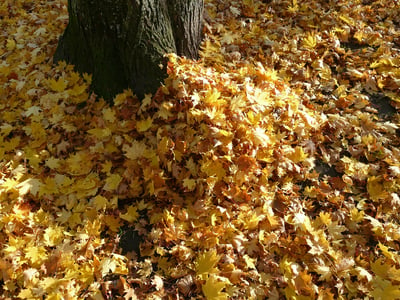At times, Klausing Group’s goal of leading the landscape industry means returning to an old practice rather than inventing a new one. Fallen leaves are a valuable resource, and the industry’s practice of removing them is often not the most practical or economical approach. Instead, we utilize fallen leaves whenever possible to improve results in the landscape.
Why Leaves Shouldn’t Leave
 In many natural ecosystems, fallen leaves are the primary material from which new layers of soil are built. Most trees have deep roots and are able to draw significant quantities of minerals up from deep in the soil. Many of these minerals end up in the leaves. As they decompose, dead leaves release these nutrients back into the soil, enriching it for the next season’s growth. Leaf compost provides a wide range of soil nutrients, from the “big three” (nitrogen, potassium, and phosphorus) to trace minerals like magnesium and boron.
In many natural ecosystems, fallen leaves are the primary material from which new layers of soil are built. Most trees have deep roots and are able to draw significant quantities of minerals up from deep in the soil. Many of these minerals end up in the leaves. As they decompose, dead leaves release these nutrients back into the soil, enriching it for the next season’s growth. Leaf compost provides a wide range of soil nutrients, from the “big three” (nitrogen, potassium, and phosphorus) to trace minerals like magnesium and boron.
Fallen leaves also provide fantastic soil structure. This enables air and water to enter the soil, which is important for root and plant health and improves drainage and the soil’s moisture holding capacity. In addition, decaying leaves provide nutrition for the beneficial microbes essential for great soil.
How We Use Fallen Leaves To Enhance Your Landscape
Leaves are never trash, whether or not they can be repurposed on a client’s property. When it isn’t necessary to remove the leaves, we employ them to enrich your property.
Shredding with a mower’s mulching blade is the best way to have healthier turf in the following year. Nutrient-rich leaf fragments sift down between the blades of grass and began to decay at the soil level. That decomposition creates a long-lasting, broad-spectrum diet no synthetic fertilizer can touch. It’s a more energy-efficient way to dispose of fallen leaves on the property, as well.
If the aesthetic of the client allows, we will also sometimes use fallen leaves as one would use hardwood mulch, in landscape beds and around shrubs. This is another very economical way to prepare a property for winter.
What We Do With Leaves That Can’t Stay On Site
 When for any reason it is appropriate to remove leaf litter from a property, Klausing Group’s partnership with local gardeners and gardening non-profits means value is retained. In Lexington, we cooperate with a local nonprofit called Seadleaf, an organization that promotes community gardening. Before delivering the leaves, we grind them up with a tool called a Billy Goat, which facilitates composting and also reduces the amount of fuel needed to transport them. If Seedleaf or another donation partner is unable to take the leaves, we deliver them to the nearest municipal composting facility.
When for any reason it is appropriate to remove leaf litter from a property, Klausing Group’s partnership with local gardeners and gardening non-profits means value is retained. In Lexington, we cooperate with a local nonprofit called Seadleaf, an organization that promotes community gardening. Before delivering the leaves, we grind them up with a tool called a Billy Goat, which facilitates composting and also reduces the amount of fuel needed to transport them. If Seedleaf or another donation partner is unable to take the leaves, we deliver them to the nearest municipal composting facility.
The Sustainable Solution for Fallen Leaves
Whether mulching them into turf, using them to mulch bedding plants, or donating them, using fallen leaves to enhance the landscape and support the community is both cost effective for the client and beneficial to people and the environment. It’s just one reflection of how we at Klausing Group strive to take a sustainable and responsible approach to the landscape.
To learn more about working with us to improve sustainability in your commercial landscape, call us at 859-254-0762 or contact us here today.
Image source: Seadleaf logo


